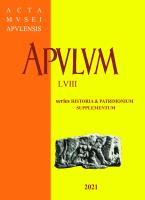Comenius în fondul de carte veche al Bibliotecii Județene „Gheorghe Șincai” Bihor
Comenius in the Old Book Holdings of the County Library ”Gheorghe Sincai” Bihor
Author(s): Silviu SanaSubject(s): History, Cultural history, Modern Age, 17th Century, 18th Century
Published by: Muzeul National al Unirii Alba Iulia
Keywords: Jan Amos Comenius; Bihor County Library; Janua Linquarum; Oratio de Cultura Ingeniorum; Jesuits; Reformed Gymnasium Salonta; education;
Summary/Abstract: The present paper aims to present from a bibliophile and pedagogical perspective, two reference prints written by Jan Amos Comenius kept in the ”Special Collections” of the Bihor County Library, meaning ”Janua Linquarum”, a work printed at Lessne, in 1633 and “Oratio de Cultura Ingeniorum”, printed by Mathias Trattner at Pesta, in 1791. Both copies belonged to the library of the Calvinist Gymnasium from Salonta (Bihor). The particularity of each copy (printing technique, content in several languages on them) successfully completes the collection of rare and bibliophile books from the “Gheorghe Şincai” Bihor County Library.Janua Linquarum is a teaching book par excellence due to its particularly rich content in all fields of knowledge. Issued in pocket format in four languages, it could be used as a dictionary, at least, by three categories of peoples: Neo-Latin, Slavic and German. This edition is the fourth edition and was made by the Jesuit Order for Catholic Schools; it also ended up in a Calvinist college, the mark that this book was the property of the Library of Calvinist College in Salonta, was a handwritten inscription, being noted the year 1808. The degree of wear and tear of the volume can be seen from the rather damaged state of the book, which indicates that the readers of the gymnasium library have often used the volume. The content of the book was rigorously organized by the publisher, having the coherence of a system that trains the reader to read the content of each title/theme, which describes elements of nature, as well as the physical, intellectual and spiritual occupations of man. The strength of the work is the Index, written in four languages, with the reader quickly orienting himself in the written text. As for the ownership insignia, due to the numerous stamps, this work belonged to the Calvinist College of Salonta, the only ex-libris inscribed on one of the tabs, being probably of a reader eager to leave his name on the book, which is noted somewhere inside the book, as if to hide his gesture. The second work entitled Oratio de Cultura Ingeniorum is, in fact, a conference of Comenius, held in Sárospatak (Hungary), on 24 November 1650. He was invited here by Prince Sigismund Rákoczy to help reform education in Hungary and Transylvania. The work is a complete 12° edition with 47 pages in Latin. The initiative to print this work belonged to the evangelical pastor, Tessedik (Theschedik) Samuel (1742-1820), a Hungarian Enlightenment personality. Using the method of interrogation and explanation, Comenius makes a well-argued plea about the use of education. He also makes a ranking of the educators that man has from birth to death. Although small, this work carries both elements of ownership of the Calvinist school in Salonta and a particularly enriched pedagogical message, valorized by printing Comenius' speech almost 150 years after its appearance. In addition to his speech at Saros-Patak, the editor added some excerpts from a rare Comenius work, proving to the reader and posterity that the great Czech pedagogue’s educational message should be known as best as possible.
Journal: Apulum
- Issue Year: 58/2021
- Issue No: 1 Supp.
- Page Range: 33-46
- Page Count: 14
- Language: Romanian
- Content File-PDF

